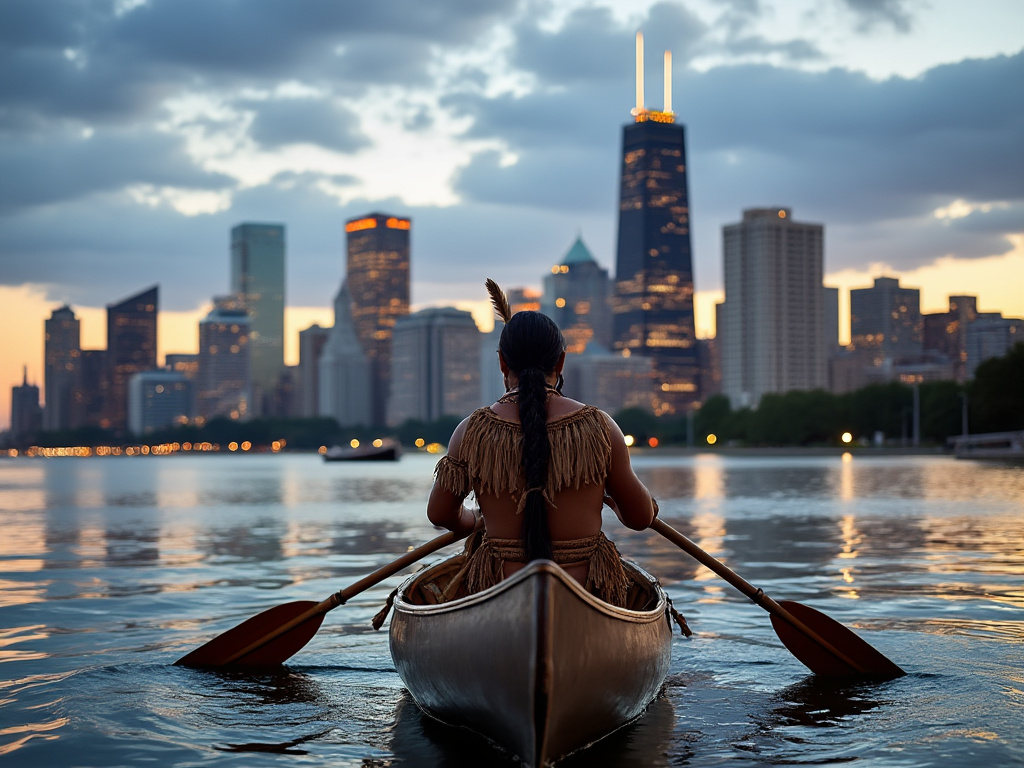
The History of Indigenous People in Chicago
Published on September 26, 2024
The Newberry Library’s newest exhibition, Indigenous Chicago, runs through Jan. 4th, 2025. eATLAS has partnered with the Newberry on Revolutionary Ride, a bike tour of political street art in Humboldt Park and Pilsen that is available in English and Spanish.
By Dave Lifton (@daveeatschicago)
The name “Chicago” is anglicized from an Algonquian word roughly pronounced as “shikaakwa.” It referred to the pungent, skunk-like aroma of a form of onions—leeks or ramps—that grew wildly in the area.
But that story doesn’t just prove that Chicago has always been a culinary capital; the odor helped the Native Americans navigate the region. It told them that they were at the spot near a muddy portage that, when traversed, connected the Chicago River and the Great Lakes with the Des Plaines River and, by extension, the Mississippi River and its tributaries.
That importance wasn’t lost on Louis Joliet and Pere Jacques Marquette, who learned of it from Indians as a shortcut back to Lake Michigan during their 1673 exploration of the Mississippi. Joliet noted that, if the portage—which ran from the present-day 47th St. and Harlem Ave. in Lyons to 31st St. and Kedzie Ave. in Little Village—was replaced by a canal, France would have control of North American waterways from Quebec down to the Gulf of Mexico.
In the centuries prior to Marquette and Joliet’s “discovery,” about 12 Indigenous nations—most notably the Potawatomi, Ojibwe, Odawa, Menominee, Miami, Sauk, Ho-Chunk, and the Meskwaki—used the area to farm the land, and to meet and trade with each other. They carved out trails, which have been incorporated into Chicago’s grid as the diagonal roads (Archer Ave., Lincoln Ave., Clark St., Milwaukee Ave., Vincennes Ave., etc.).
Alliances between the Tribes, known as Anishinaabe, were often conducted through intermarriage and allowed them to prosper because Indians were more likely to do business with those they knew. The most prominent Anishinaabe in the region was the Council of Three Fires, made between the Ojibwe (Keepers of the Faith), Odawa (Keepers of Trade), and Potawatomi (Keepers of the Fire), which was believed to have started in 796 AD at what is now Mackinac Island in Michigan.
The rich Illinois soil was ideal for growing grains, mostly wheat and corn, with the surplus sold to missionaries and other Europeans that were coming through the region. During this time, the land belonging to the Council of Three Fires was claimed by France and ceded to Great Britain in 1763 following the French and Indian War.
As European traders began doing business in the Great Lakes region, they discovered the benefits of marrying Indigenous women. They were welcomed into the Tribes, which expanded their business, and the women would assist their husbands by translating.
One of those traders, the son of a Frenchman and an enslaved African named Jean Baptiste Point DuSable, married Kitihawa, a Potawatomi, in 1778. Shortly thereafter, the couple built an estate on the north bank of the mouth of the Chicago River, making DuSable the first permanent non-Indigenous settler of Chicago.
The DuSables stayed in Chicago until 1800, selling his land to Jean La Lime. By then, however, the newly created United States of America was looking to expand westward, leading to hostilities between Indians and federal troops. As part of the Treaty of Greenville (1795) that ended the Northwest Indian War, the U.S. took six square miles centered by the mouth of the Chicago River.

The Army erected Fort Dearborn in 1803, across the river from La Lime’s compound. In the run-up to the War of 1812, the British aligned themselves with Native forces as relations between the federal government and the Potawatomi worsened. Two months into the war, the U.S. looked to evacuate Fort Dearborn for Fort Wayne, Ind. On the morning of Aug. 15th, the 96 residents of the fort had barely left their post before they were ambushed by 500 Potawatomi warriors. In 15 minutes, all the Americans were either killed or captured, and the fort was burned to the ground.
The loss at the Battle of Fort Dearborn led to the federal government taking further action against the Natives. Between 1816 and 1833, three treaties—plus the Indian Removal Act of 1830—removed the Council of Three Fires from their ancestral land and relocated them west of the Mississippi, paving the way for the birth of the City of Chicago.
In the 1950s, the Eisenhower Administration ended federal recognition of many Tribes and cut funding for services on reservations, and many Indians relocated to cities, including Chicago. The American Indian Center in Albany Park was established in 1953 to help them assimilate into urban life and promote their culture.
As of 2017, there are 65,000 people of Native American ancestry living in the Chicago area, although there are no federally recognized Tribal lands in Illinois (itself an Ojibwe word for “He speaks the regular way”). And the City of Chicago is much more cognizant of its past. Land acknowledgements at government buildings and local institutions are commonplace and, in 2021, a 15’ x 266’ mural by Ojibwe artist Andrea Carlson that read “You are on Potawatomi Land” in English and Potawatomi was erected on the Riverwalk and remained for two years.
One thought on "The History of Indigenous People in Chicago"
Leave a Reply

The Adventure starts when you say it does.
All eATLAS Adventures are designed and built by experienced eATLAS Whoa!Guides. They're always on. Always entertaining. And always ready to go.
Check out our Adventures!
No sé dónde leí que anteriormente
en tiempos Pre-Colombinos, Chicago fue.una ciudad Tolteca.
Francisco Carrillo Gil